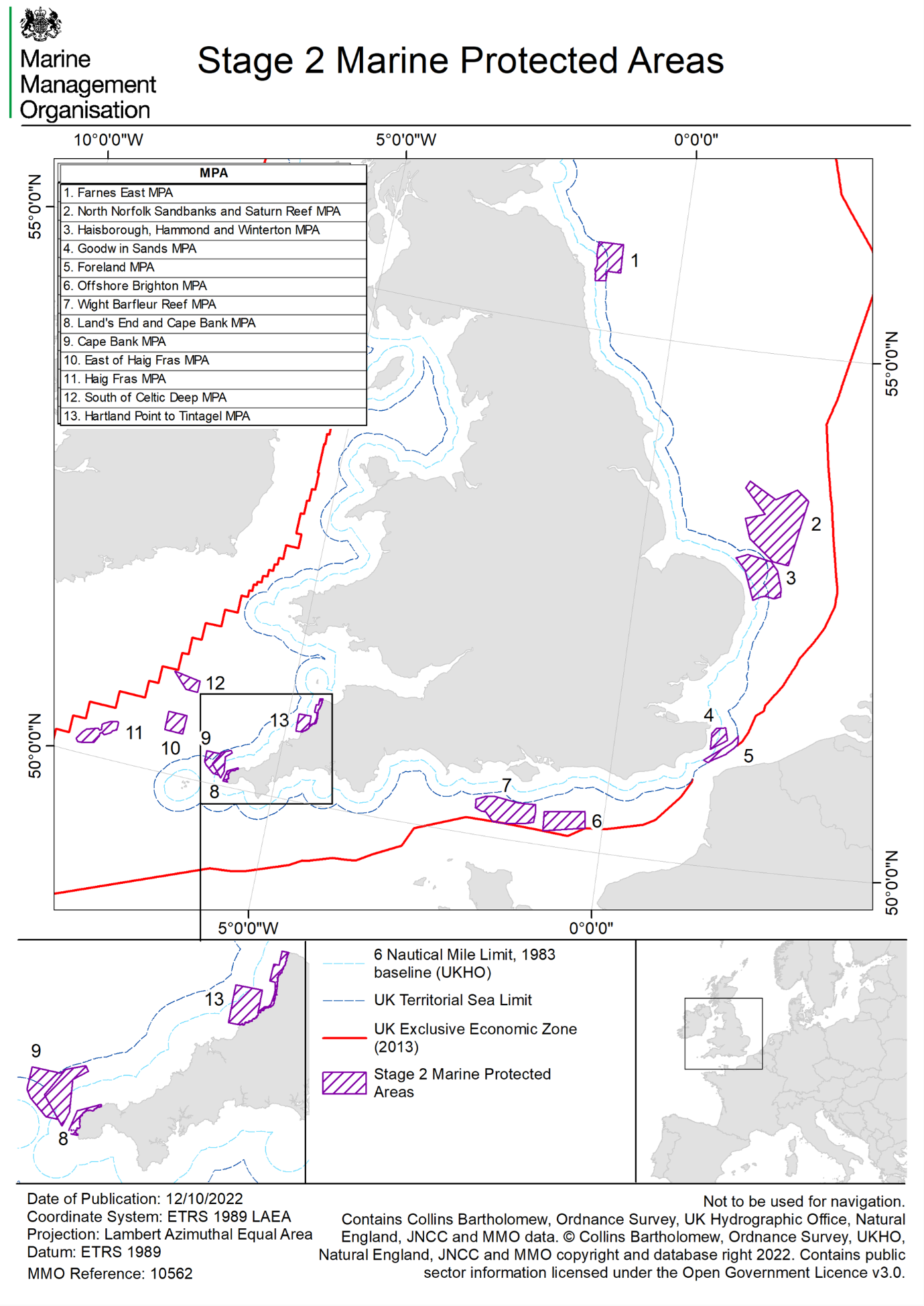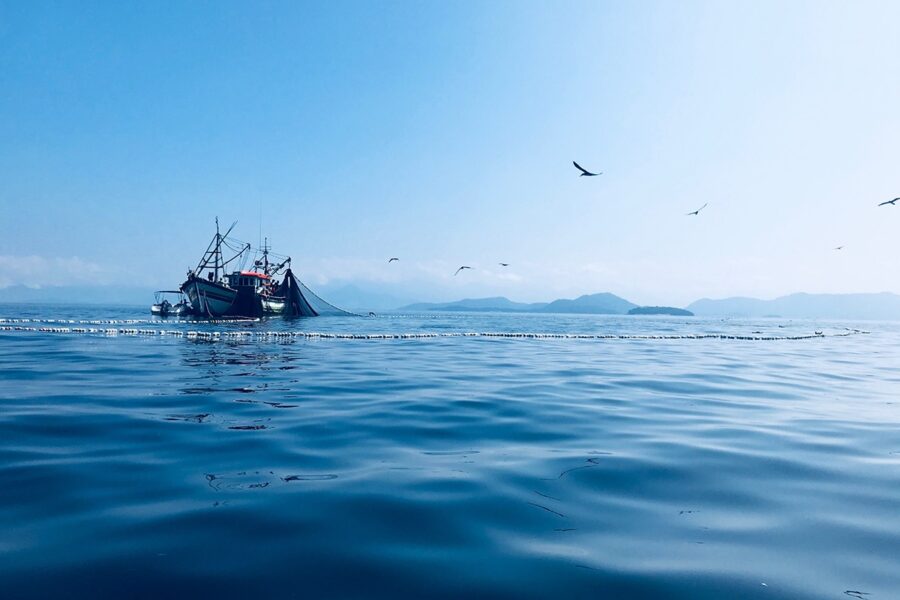The MMO has launched a consultation on proposals to ban bottom trawling in another 13 MPAs in English waters, reports Tim Oliver.
They are the latest stage in ‘an ambitious programme to protect all 40 English offshore MPAs from harmful fishing activity by 2024’, says Defra. Byelaws are already in place in key sites including Dogger Bank and The Canyons.
These measures in 13 MPAs will protect marine ecosystems in an area of over 4,000 square kilometres. The new byelaws will bring the total area protected from bottom-towed gear by MMO byelaws to almost 18,000 square kilometres. A total of 178 MPAs cover 40% of English waters.
The NFFO slammed the consultation, and the overall process of managing MPAs, for their failure to put in place any strategy or framework to address the displacement effects. It also condemned the rushed timetable, which it said would result in a ‘box-ticking exercise’.
Locations that would gain protection include Cape Bank, home to ecologically important species such as pea urchins and a type of starfish called a cushion star, Haig Fras, a site that supports a variety of fauna including jewel anemones and solitary corals, and Goodwin Sands, home to rocky habitats that support species such as pink sea fans, cup corals and commercially important fish and shellfish.
The proposed byelaw is part of stage 2 of the MMO’s work to manage fishing in England’s offshore MPAs. This stage focuses on the management of bottom-towed gear over rock, and rocky and biogenic reef features, which are some of the most sensitive to the impacts of bottom-towed fishing.
The MPAs considered in Stage 2 are Cape Bank, East of Haig Fras, Farnes East Foreland, Haig Fras, Haisborough, Hammond and Winterton, Hartland Point to Tintagel, Goodwin Sands, Land’s End and Cape Bank, North Norfolk Sandbanks and Saturn Reef, Offshore Brighton, South of Celtic Deep and Wight-Barfleur Reef (see map below).

The consultation will run alongside a call for evidence to gather views on the impacts of anchored nets and lines, bottom-towed fishing gear and traps on valuable marine features such as reefs and sandbanks across England’s MPA network (see right).
Environment secretary Thérèse Coffey said the UK has a strong track record on marine protection. “Today’s plans will deliver more crucial safeguards for vital biodiversity and help restore England’s marine ecosystems,” she said.
“We’ll listen carefully to the responses to ensure we help habitats and species recover whilst ensuring we have a sustainable and successful fishing industry for years to come.”
Tom McCormack, chief executive of the MMO, said the formal consultation follows its call for evidence last year on the impacts of bottom-towed fishing in the 13 MPAs. “We look forward to engaging with stakeholders and interested parties on the byelaw proposals.”
Defra said the announcement was another step forward in the UK’s commitment to protect at least 30% of the global ocean by 2030, known as ‘30by30’. “The UK’s comprehensive network of 374 MPAs protecting over 38% of UK waters will be a valuable contribution to this global target.”
The global 30by30 target was adopted at a UN conference in Montreal on global biodiversity last December.
“UK efforts, including as leader of the Global Ocean Alliance and ocean co-chair of the High Ambition Coalition for Nature and People, helped to secure agreement on this important global target,” said Defra.
The formal consultation and the call for evidence run from 17 January to 28 March.
Call for stage 3 evidence
The MMO is seeking additional evidence and views on its draft ‘Stage 3 Fishing Gear MPA Impacts Evidence’ documents in relation to the impacts of fishing on designated features in MPAs.
It says these documents ‘collate and analyse the best available evidence on the impacts of fishing gears on MPA features, and will inform site-level assessments of the impact of fishing on MPAs as part of Stage 3 of the MMO’s work to manage fishing in MPAs’.
MMO held a call for evidence for Stage 2 MPAs between 14 May and 10 July 2022, which focused on interactions between bottom-towed fishing and rock and reef features.
Stage 3 covers all remaining interactions between fishing gear and designated seabed features within MPAs not already assessed in Stages 1 and 2. The impacts of fishing on MPAs designated for marine birds and harbour porpoise will be addressed in a separate Stage 4.
MMO has drafted three ‘Stage 3 Fishing Gear MPA Impacts Evidence’ documents, each focused on the interactions between seabed MPA features and a particular fishing gear group: bottom towed gear, anchored nets and lines, and traps.
This call for evidence opened on 17 January and closes on 28 March.
NFFO: Displacement effects ‘ignored’ and timetable ‘ridiculous’
Responding to the proposed ban on bottom trawling in 13 more MPAs, the NFFO said its principal concern was that the government had not addressed the cumulative impact of the potential displacement of fishing activities.
The federation also criticised the ‘ridiculous’ rushed timescale of imposing management regulations in MPAs.
It said the NFFO/SFF- commissioned ‘spatial squeeze’ report undertaken by ABPmer last June spelt out the scale of potential displacement.
“Until there is a comprehensive cross-government policy framework to deal with displacement, it seems misconceived to proceed with expanding the MPA network on an incoherent ad hoc basis,” NFFO chief executive Barrie Deas told Fishing News.
“There needs to be a balance between protecting vulnerable habitats and species, protecting coastal communities and providing food security. There is no such policy framework in place.
“The scale of change is unprecedented. There is an enormous expansion of offshore wind farms and of MPAs that will create large-scale displacement.
“In the case of MPAs, it will depend on what the management measures are, but we can see even on a conservative estimate there’s going to be very large- scale displacement. What are the consequences of that?
“As well as the socio- economic consequences, what are the ecological consequences of displacement? If you’re pushing bottom trawling out of an area, where’s it going to go? What impact will it have in that area? There’s good reason to be concerned about displacement, given what’s happened in the past.
“With offshore wind and the other cumulative effects, as the ABPmer report makes very clear, we are facing change on an unprecedented scale, which is all the more reason to think more carefully about the implications in the round.”
Barrie Deas said he understood that work was going in separate departments such as Defra, Cefas, the MMO and the Joint Nature Conservation Committee (JNCC) – but a cross-government discussion was needed to develop a strategy to manage displacement, and other organisations should be brought in, such as the Crown Estate.
“We need a framework that manages displacement and takes into account the scale of what’s coming at us, but there is no sign yet that that is happening.
“From the outset when this ridiculous timeframe was set, we flagged up that it would be impossible to do a proper job within that timeframe in terms of gathering evidence, assessing evidence, and most importantly evaluating the consequences of displacement.
“We have got a self-imposed timeframe, which make it look like a box-ticking exercise rather than a serious attempt to achieve the balance between protecting vulnerable habitats and species, protecting coastal communities and producing food.”
He said if the government was serious it would be taking the process much more slowly, seeing what works and doesn’t work, and developing the policy over a reasonable timeframe.
“Evidence from all international comparisons shows that this achieves better outcomes in the end, but the MMO has been given this task by the politicians who just want the green credits – that’s what it boils down to, I think.”
He said the ban on bottom trawling reflected the conservation advice the government gets from the JNCC.
“They are mostly talking about rocky reefs, and it’s logical that the fishing method that will have the biggest impact on rocky reefs is bottom gear,” he said.
“We’re certainly not saying these habitats don’t need protection, but we need an evidence-based approach to determine how best to protect them – it may be that a closed area is right in some cases.”
He said the NFFO executive committee would be discussing the consultation and its response at a meeting this week (25 January).
This story was taken from the latest issue of Fishing News. For more up-to-date and in-depth reports on the UK and Irish commercial fishing sector, subscribe to Fishing News here or buy the latest single issue for just £3.30 here.








